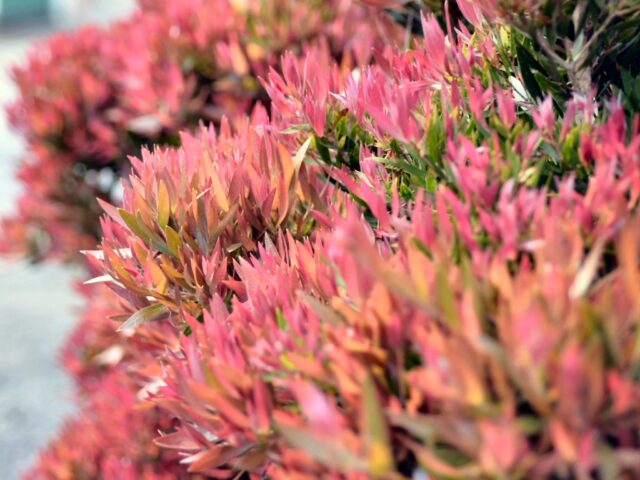In the last newsletter, we had little idea of just what challenges lay ahead. With the country facing such dire threats from fire, our thoughts are with everyone affected. And we are in awe at the efforts of all the volunteers who have worked so hard and continue to do so, this country owes them so much. We hope this will be a chance to really look at what we can all do to work together at the start of this new year, and new decade.
We want to share some horticultural news this month to focus on the regenerative capacities of our communities, our great Australian plants and our ecosystems.
There are some great new cultivars that have come out recently, including some Callistemons that Angus personally bred. These varieties were selected for their foliage so they are ideally suited to hedging and topiary work, and can be used instead of plants that originate in other countries. Callistemon ‘All Aglow’ can grow to a medium-sized shrub in the right conditions, typically around 2.5 metres in height, but it can vary. It can be used as a screen or along fence lines, and while the colourful foliage is the outstanding characteristic of this variety, it also produces purple-pink flowers. Angus has used it to great effect in the garden, creating an alternating hedge of Callistemon ‘Great Balls of Fire’ and ‘All Aglow’ (pictures below). If you’re familiar with ‘Great Balls of Fire’, then this is a plant that’s going to provide a similar effect in the landscape, but with the added bonus of the bright nectar rich flowers which are highly bird and insect attracting…..good for habitat building.
Another cultivar from this breeding project is Callistemon ‘Baby Glow’, which is a dwarf form ideal for topiary and small border hedges. This cultivar produces stunning sunset-coloured foliage which will brighten up the garden. Like ‘Great Balls Of Fire’, it rarely or never flowers, which some people like as it takes away the need to dead head spent blooms. The dense foliage will still give cover to small birds and other creatures though.
The outstanding feature of these new Callistemon varieties is that if you prune and fertilise them during the warmer months of the year, they’ll produce a kaleidoscope of colourful foliage. Any general purpose fertiliser is fine for these plants as they’re not phosphorus-sensitive. These are great alternatives to exotic hedge plants.
Brachyscome multifida ‘Mauve Mystery’ is a beautiful new native daisy cultivar which makes a wonderful groundcover, hanging plant, or border for garden edges. Angus noticed this plant growing in an inland garden where it endures extreme temperatures, both hot and cold. Because it has adapted to withstand this environment, it is a very hardy garden plant which can be grown in a range of climates, including areas with extreme heat and frost. Aside from its hardiness, the other unique feature of this cultivar is that it has unusual bicoloured flowers. The individual blooms can be either pure mauve, pure white, or a combination of mauve and white on the same flower head. It’s a tough perennial that blooms right through the warmer months of the year, and is able to survive with low levels of watering, something that is increasingly necessary. In terms of maintenance, it just needs a good prune after flowering and some fertiliser and it will flower again.
These new varieties are currently building up in wholesale nurseries and will start to become available in retail nurseries over the next 12 months, so be sure to visit our sponsor nurseries who will be stocking these varieties. If they don’t have them in stock, just check in and they can order the new varieties for you.
On the farm, Angus is excited about the new vegetable garden getting underway. He is growing 25 varieties of heirloom tomatoes sourced from the Hobart Botanic Gardens annual tomato sale, and they are starting to produce some beautiful fruit. He’s also growing a range of other vegetables, such as lettuce, spring onions, kale, and a variety of herbs. He is putting into practice sustainable principles with the garden and farm, with a view to improving and enriching the soil, and with the idea of leaving things in a better state for future generations. This is also what he has been expanding upon with his work in Hobart at the Edible Precinct. The idea of living a more considered life involves hard work, but is very satisfying too!
Angus will be at the Koonya Garlic Festival in Tasmania on Saturday, 29 February 2020. The Koonya Garlic Festival is an annual event that has become firmly established on the Tasmanian festival calendar. As a local resident, Angus is on the organising committee, and this year the headline speaker is Tino Carnevale. The topic of Tino’s talk will be ‘A celebration of the garlic family – not just the famous cousins!’ Angus will be doing a Q&A session with Tino, and his major focus this year is on creating a zero-waste event. Angus will be running live demonstrations all day on composting and waste sorting, educating people on what can go into home compost versus what needs to go to industrial-scale, council facilities. Naturally there will also be live worm farms, and Angus will be opening up a can of worms and giving away free worms to festival goers!
For more information on the Koonya Garlic Festival, visit the festival website at koonyagarlicfestival.org.




